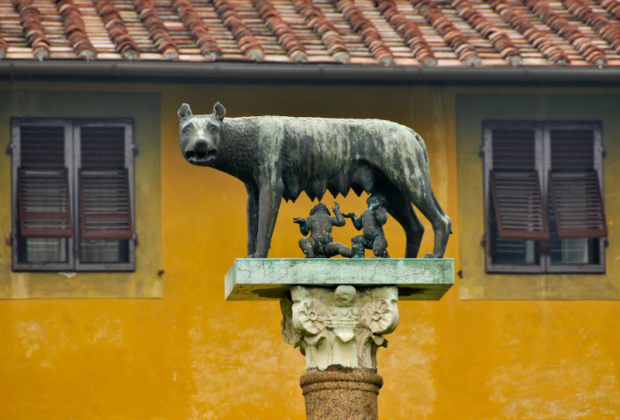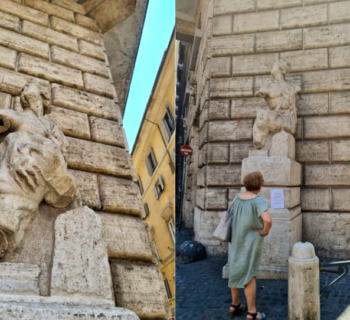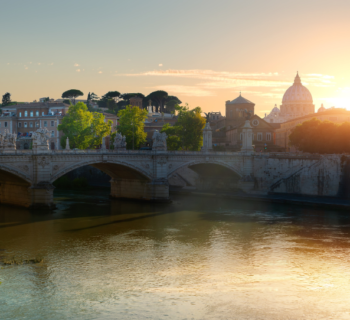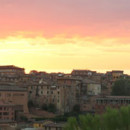Livello: B1-B2
"SI FUERIS ROMAE, ROMANO VIVITO MORE"
This famous ancient Roman saying literally means: When in Rome, do as the Romans do. And for the Romans, the most important thing to do was attain glory.
To quote Cicero: "…it is what makes us present even when we are absent, what makes us live even if we are dead; and it is ultimately the ladder by which man can even climb into heaven."
But how has the Rome brand managed to survive all these years? Has it been thanks to its secular monuments? The epic deeds of Julius Caesar? Or perhaps its scenographic settings and role as the legal and spiritual headquarters of one of the most followed religions in the world?
To answer this question, let's take a step back… a step back to the fall of Troy in 1250 BC. A handful of defeated Trojans, led by Aeneas, the son of Anchises and Venus, were exiled from a city engulfed in flames. In search of a new home base, they arrived in Laurento, an ancient city in Lazio near Lavinio. The group settled down and lived there alongside the locals. Aeneas reigned, Ascanius reigned, his son and his son's son reigned, just as fate had intended. But when the Silvia dynasty arrived, violence came to the throne spearheaded by two brothers: Numitor the older and Amulius the younger, the latter of whom had ordered the execution of his brother's male children in addition to condemning his sister Rhea Silvia to permanent chastity.
But the Vestal Virgin, a victim of rape, gave birth to a set of twins whom she declared to be the children of the god Mars. The cruelty of her king-brother led to the two little ones being thrown into the Tiber River. Yet no amount of human cruelty can interfere with a divine plan for long. So it was that a shepherd found a she-wolf lovingly nursing two newborns along the riverbank. He took the children and raised them with his wife. The boys, who were strong in body and spirit, grew to steal from bandits and divided their plunder amongst the other shepherds. Between the entertainment and work to be done, the number of youths in the area steadily increased over the years.
One day, Remus was captured and brought to his overbearing uncle, King Amulius. Numitor, his affectionate uncle, then interrogated and ultimately recognized him. Touched deeply both by the vitality of his nephews and their narrow escape from death, Numitor co-conspired a plot with his two nephews. Thanks to an attack leveraged by the twins and other young resistors, the usurping uncle Amulius was killed, and Alba was returned to Numitor.
A strong desire was then born within the two boys: to found a new city. But naturally since the twins were unable to follow the right of primogeniture whereby the first-born child succeeds the throne, once again it was up to the gods to choose a ruler and bestow a city in their name. The two brothers were to compete against one another in an augury. Romulus positioned himself on the Palatine hill while Remus made way for the Aventine hill. They each counted the number of passing vultures. Remus ultimately saw six, which was double that of Romulus, but time had run out. The prophecy was confusing and a dispute inevitably arose between them.
The two brothers, who had grown up loving each other, suddenly found themselves in a clash that went from heated words to real blows. Remus climbed over the wall that Romulus had just erected in an attempt to make fun of him. In turn, Romulus, full of anger, killed Remus as he shouted, 'May anyone who dares climb over my walls die!'
This was back in 753 BC. Afterwards, Romulus vowed to build on the site the largest and most powerful city the world had ever seen. A city that would be capable of overthrowing any tyrant, a place that all Latins could call home without facing unnecessary distinctions and prejudices. This city was to be given the name of Rome.
So history can partly answer our initial question. The Rome brand that has survived for 2777 years was born from a blood bond, both fraternal and fratricidal, from piety and revenge to forgiveness and free will. Rome was already an ideal even before it became a real place in flesh and in spirit.
Ida Salvi
Scuola Leonardo da Vinci Rome
The Eternal City has known it all. Victory and defeat, joy and tragedy, glory and humility marked Rome’s history, culture and architecture. A magical place with vibrant, timeless lifestyle with countless secrets waiting to be discovered.
The Scuola Leonardo da Vinci is situated in the centre of Rome, in the pedestrian area, halfway from the astounding Piazza Navona, Castel S. Angelo and St. Peter Basilica. It is one of the largest schools in Rome.
We, from Leonardo da Vinci School have one mission – to introduce you to this exciting urban symphony. Every year thousand of students from more than 90 countries jump into this adventure hand in hand with us. Leonardo da Vinci School is not only leading language institute, but centre of Italian culture and lifestyle. We match our vast experience with our student’ eagerness to know and learn and together we make it happen.
Latest posts by Scuola Leonardo da Vinci Rome (see all)
- What to Do in Rome During Christmas - December 22, 2025
- Living and learning Italian in Rome: the guide for international students - September 26, 2025
- ROME: DISCOVERING THE MAXXI - August 5, 2025









